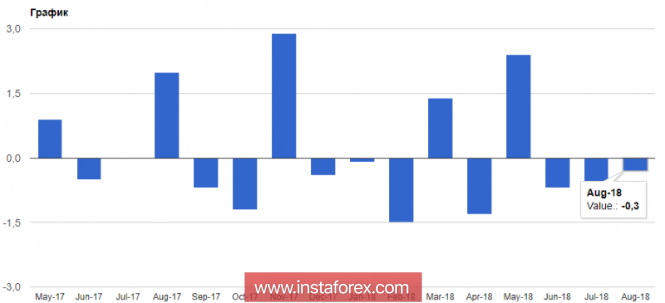The European currency continued to decline against the US dollar and a number of other world currencies, as many investors and traders fear that in the near future the leading rating agencies will lower the credit rating of Italy.
Despite the fact that the Italian government bond market already partially takes into account the reduction of the country's credit rating of Moody's agency by one level, one should not forget about the S & P agency, in which a lowering of the credit rating will lead to an even greater increase in the spread between the yield of government bonds of Italy and Germany. In turn, this will lead to another reduction in risky assets and collapse the European currency at new monthly minimums.
Basic data
As for the fundamental statistics released yesterday, the decline in industrial production in Germany for August this year also had a negative impact on the European currency. As indicated in the report, the construction industry suffered the most.
According to the data of the Ministry of Economics of Germany, the volume of industrial production in August fell by 0.3% compared with the previous month, while economists did not forecast changes in production volumes.

As I noted above, the volume of production in the construction sector immediately fell by 1.8%, pulling down the main indicator.
The index of employment trends in the US from the Conference Board fell in September of this year. According to the data, the index was 110.77 points the August against the value of 111.18 points. Compared to last year, the index increased by 6.7%.
The presentation of the representative of the Federal Reserve Bank of St. Louis, James Bullard, was perceived as generally positively by the market. Bullard said that economic growth in the United States will continue only under conditions of stronger productivity growth rates, and a demographic factor will affect negatively the growth potential.
Bullard also changed his attitude about raising interest rates while not making any predictions about monetary policy in the future. This indicates the strength of economic growth in recent years has allowed the Central Bank to make the expected rate increases.
As for the technical picture of the EUR/USD pair, buyers hit the restrained support area of 1.1460, while its repeated test may lead to an increase in short positions in risky assets and a further decline of the euro with the trend towards monthly lows of 1.1400 and 1.1355. If buyers cope with the next pressure, their main task today will be returning the trading instrument to the resistance level of 1.1500, which is where the further short-term direction of the market will depend on. An upward potential will also be limited to a maximum of 1.1450.
The material has been provided by InstaForex Company - www.instaforex.com